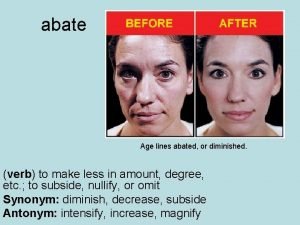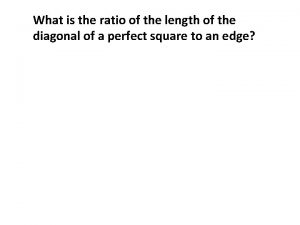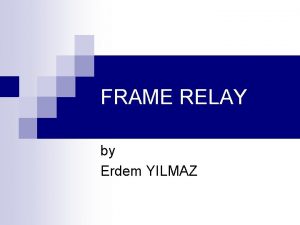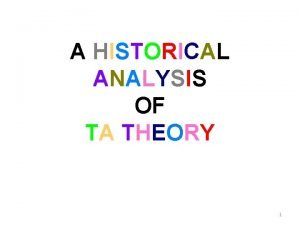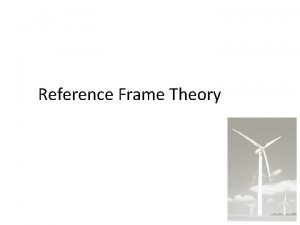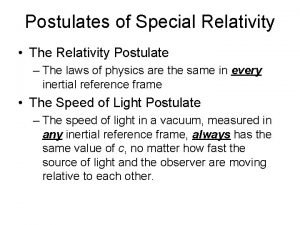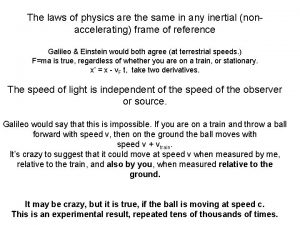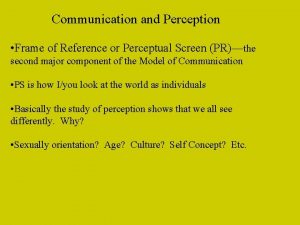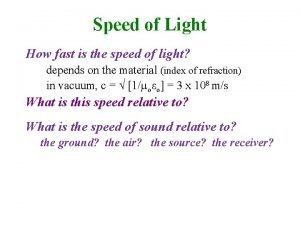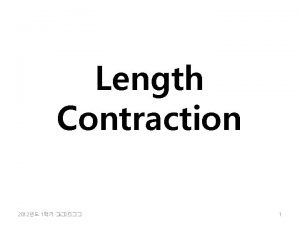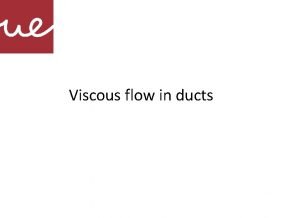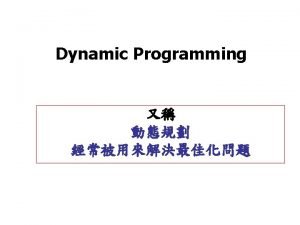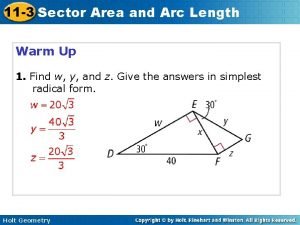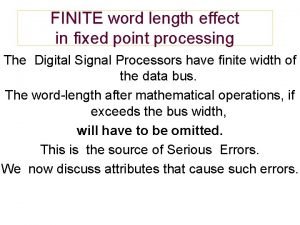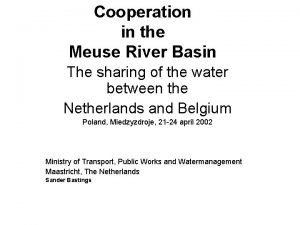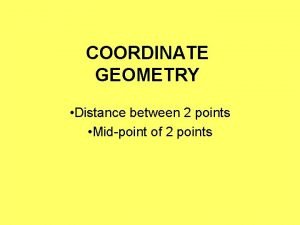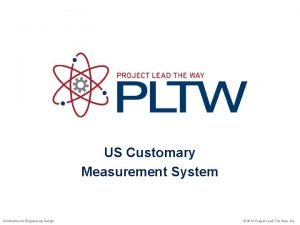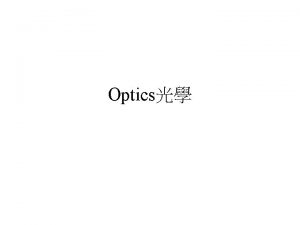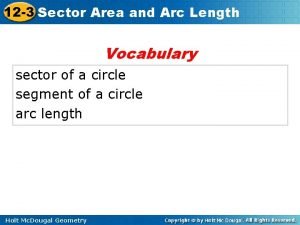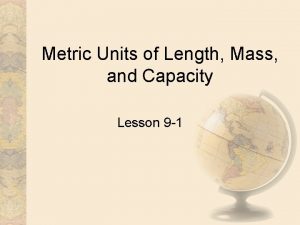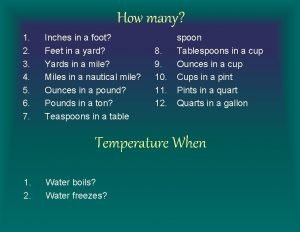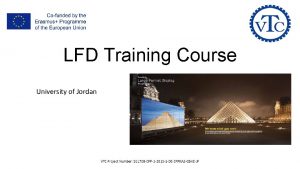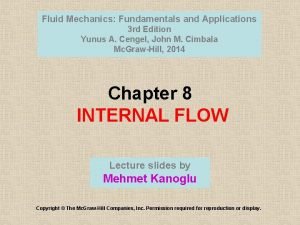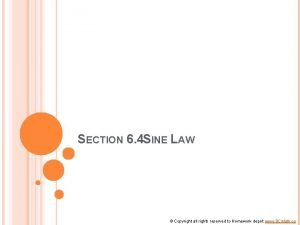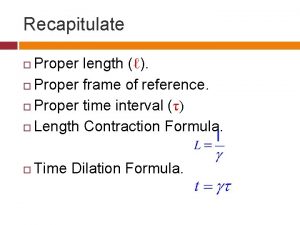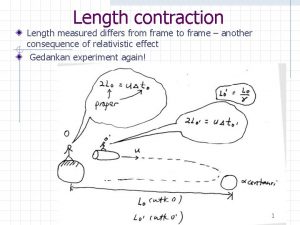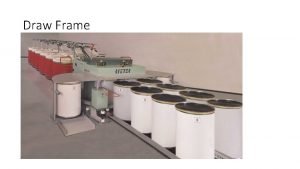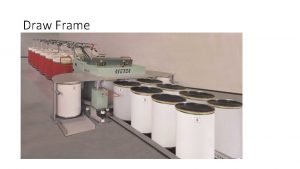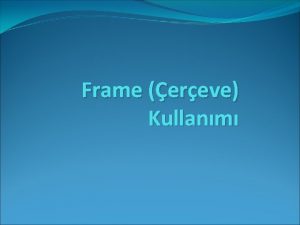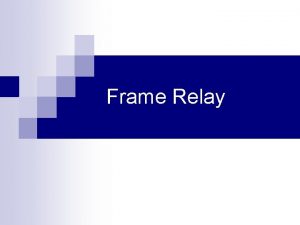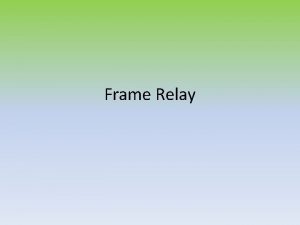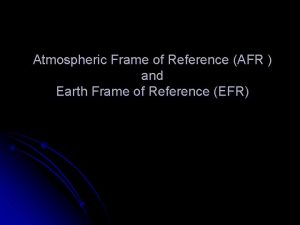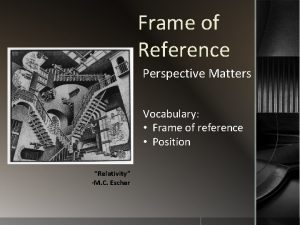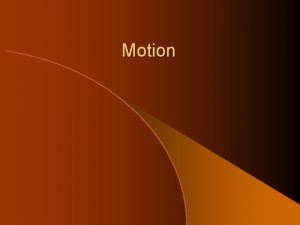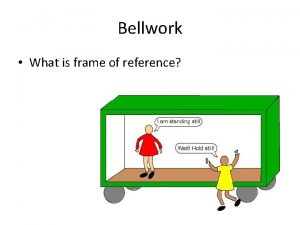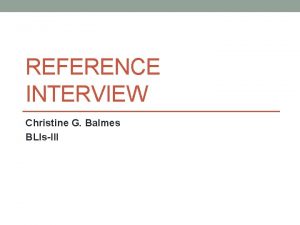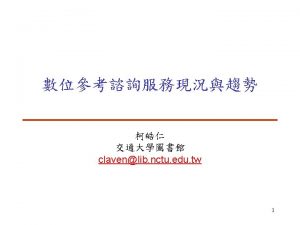Recapitulate Proper length Proper frame of reference Proper





































- Slides: 37

Recapitulate • Proper length (ℓ). • Proper frame of reference. • Proper time interval ( ) • Length Contraction Formula. • Time Dilation Formula.

Measuring Length of Platform Measurement of length of a platform by an observer stationary on the platform and another moving in a train with relativistic speed. Assume both frames to be inertial.

S’ v S A B

Define Events E 1: The origin of S’ coinciding with end A of platform. E 2: The origin of S’ coinciding with end B of platform.

In S E 1: (x 1, t 1) E 2: (x 2, t 2) Is x 2 -x 1= L ? Is t 2 -t 1 proper ?

In S Length is proper.

In S’ E 1: (x’ 1, t’ 1) E 2: (x’ 2, t’ 2) Is x’ 2 -x’ 1= L’? Is t’ 2 -t’ 1 proper?

In S’

Applying inverse transformation.

-Meson Shower The incoming primary cosmic rays create -meson in the upper atmosphere. The life time of mesons at rest is 2 s. If the mean speed of meson is 0. 998 c, what fraction of mesons created at the height of 20 km reach the sea-level?

Assume -mesons to travel with constant speed. Decay time interval 2 x 10 -6 s is proper in -meson frame. In earth frame it is dilated. c=0. 998 c gives = 15. 82 Decay time in earth frame =15. 82 x 2 x 10 -6 s = 3. 164 x 10 -5 s

Time to travel to earth in earth frame =20 x 103/0. 998 c = 6. 68 x 10 -5 s The fraction reaching earth in earth frame can be calculate using

This fraction is 0. 12. Classically it would have been 3. 12 x 10 -15. What would an observer in – meson frame conclude?

Old Problem about Light Emission S’ c S c v

Events E 1: Light reaching front wall of the train. E 2: Light Reaching the back wall of the train.

In S’ Frame

Event 1 in S Frame Assume origins were coincident when light was emitted.

Event 2 in S Frame

As expected, we see that The time difference is given below.

Co-ordinate Difference The difference in co-ordinates of two events. Is it related to the length of compartment? In which frame the length is proper?

The x 1 -x 2 is an overestimate of length of the train because t 1>t 2. Can we get correct length? Yes, if we can find out the distance the train moved in the time difference.

vΔt x 2 x 1

Length in S

Velocity Transformation We know the components of velocity a particle in S and want to find the same in S’ for the same particle.

Notation Relative velocity between frames. Constant as a function of time. Instantaneous velocity of particle is S. Need not be constant. Instantaneous velocity of particle is S’. Need not be constant.

Events related to Displacement Imagine that a particle is moving in x- direction in a frame S. E 1: Particle found at x 1 at t 1. E 2: Particle found at x 2 at t 2.

Even if the velocity of particle is not constant in the limit Δt tending to zero would give the instantaneous velocity of particle in S.

If the motion is in threedimension, in general

Similarly looking at the same particle in S’, we can define:

Note that like displacement, the time difference has also to be measured in one’s own frame.

Lorentz Transformation in differential form.




Velocity Transformation

Inverse Velocity Transformation

Comment One can show that • If u<c in S, u<c in S’ also irrespective of v. • If u=c in S, u=c in S’ also irrespective of v.
 Equivocate adjective
Equivocate adjective What is the ratio of the length of to the length of ?
What is the ratio of the length of to the length of ? Frame relay frame format
Frame relay frame format Frame by frame animation programs
Frame by frame animation programs Pengertian animasi frame by frame
Pengertian animasi frame by frame Frame relay frame format
Frame relay frame format Brand mantra
Brand mantra Bull's eye brand positioning
Bull's eye brand positioning Frame of reference
Frame of reference Contoh frame of reference dan field of experience
Contoh frame of reference dan field of experience Jacqui and aaron schiff
Jacqui and aaron schiff Inverse park transformation
Inverse park transformation The law of relativity
The law of relativity Contoh frame of reference dan field of experience
Contoh frame of reference dan field of experience Inertial frame of reference
Inertial frame of reference Inertial frame of reference
Inertial frame of reference What is frame of reference in communication
What is frame of reference in communication Frame of reference units
Frame of reference units Speed of light in vacuum
Speed of light in vacuum Length contraction formula
Length contraction formula Reference node and non reference node
Reference node and non reference node Reference node and non reference node
Reference node and non reference node Who has defined style as proper words in proper places
Who has defined style as proper words in proper places Vertical
Vertical Given a rod of length n inches
Given a rod of length n inches 11-3 sector area and arc length
11-3 sector area and arc length Finite word length
Finite word length Meuse length
Meuse length Length formula coordinate geometry
Length formula coordinate geometry Flux unit weber
Flux unit weber Customary units of length
Customary units of length Concave lens cases
Concave lens cases 12-3 sector area and arc length
12-3 sector area and arc length Standard unit of length
Standard unit of length Km-hm-dam-m-dm-cm-mm liter
Km-hm-dam-m-dm-cm-mm liter Vga max length
Vga max length Laminar flow
Laminar flow Sine formula
Sine formula
